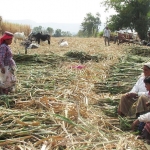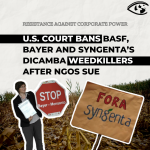UK: Patents on Flowers: Profits to Blossom?
The European Patent Office is currently considering an application by crop science giant Syngenta to control the DNA that regulates the way flowers grow in rice plants. Not only will this give Syngenta control over rice crops, but it could also be generalised by patent lawyers to apply to controlling the flowering of plants in general - including 23 major food crops and maybe even plants yet unknown. This comes at the end of the United Nation's 'Year of Rice' 2004, which saw both private and public bodies come close to completing their sequences of the rice genome.
Syngenta are currently the world's biggest agrochemical firm, just ahead of Bayer, and the world's second biggest seed seller, just behind Dupont and Monsanto; in the shrunken world of genetically modified food they are now the company most likely to succeed. Control of these patents on rice would give them a foothold in the world's largest food crop, and also a strong ability to expand in the future into similar plants.
Rice is the crop with the single most important role in directly feeding humans. This is mainly because of the vast number of small-scale paddy fields that exist in China, India and Indonesia. Therefore rice is not an international commodity in the same way that soya or wheat is, rather the rice DNA is important because it will be one of the first major crops to have its DNA sequence fully recorded. This opens up a whole range of similar ('homologuous') plants to researchers and companies, and Syngenta want to be there first.
In many ways they are already the first, having beaten both the publically-funded International Rice Genome Sequencing Project (IRGSP) group and its corporate rivals in January 2001 by sequencing the genome of japonica rice. Public pressure has led to Syngenta passing on some of this information to the public domain in 2002, but Syngenta's strategy has always been to trickle out some of its research, while simultaneously making sure that any profits from the DNA fall within their own domain. The pending patents on flowering development are part of this overall plan.
However it is this carefully cultivated reputation as a public domain benefactor that is one of Syngenta's tickets onto the governing bodies of food and agriculture. The Syngenta Foundation is a member of the Consultative Group on International Agricultural Research (CGIAR), made up of 15 research centres whose goal is to generate 'global public goods that are available to all'.
According to the ETC group they are also 'becoming common fixtures in the UN Food and Agriculture Organization's corridors in Rome,' in keeping with Kofi Annan's policy of developing corporate partnerships. They were recently rebuffed from the WFF's Round Table on Sustainable Soya by the farmers' and NGO representatives (see [insert name here] in this news update), but in general Syngenta have managed their public image much more successfully than Monsanto or Dupont, and this has paid off. With a presence in the CGIAR and lobbying influence with the UN, Syngenta have a presence within the very bodies that, in theory, should be regulating their power.
- 181 Food and Agriculture



